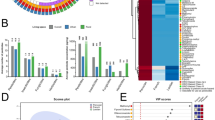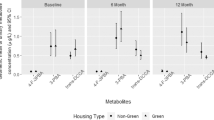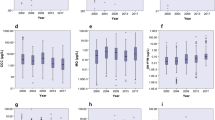Abstract
We evaluated 2,4-dichlorophenoxyacetic acid (2,4-D) exposure in four municipalities with and without cosmetic pesticide bylaws in British Columbia, Canada. We recruited a child (aged 1.5–5 years) and adult from 10 households in each city, who provided urine samples in May and June, 2009. No households had used pesticides for 7 days prior to sample collection. We quantified urinary 2,4-D using LC/MS/MS. Quantities of 2,4-D in urine were similar across cities and below biomonitoring equivalents corresponding to references doses in the United State of America and Canada. When adult’s and children’s urines were analyzed together in linear mixed-effects regression models, natural log urinary 2,4-D was significantly associated with having a diet of ⩾50% organic food (β=−0.6 (0.3) μg/l, P=0.05). Without natural log transformation, median concentration of urinary 2,4-D among those who ate ⩾50% organic food (n=12) was 1.4 μg/l versus 1.5 μg/l for others (n=59). Lack of a significant association (two-sided alpha=0.05) between pesticide bylaws and urinary 2,4-D might reflect small sample size, lack of recent acute exposure, or that 2,4-D exposure is primarily influenced by sources of exposure not addressed through bylaws. Food might be a route of exposure to 2,4-D, consistent with other studies. Future research will require larger sample sizes for sufficient statistical power.
This is a preview of subscription content, access via your institution
Access options
Subscribe to this journal
Receive 6 print issues and online access
$259.00 per year
only $43.17 per issue
Buy this article
- Purchase on Springer Link
- Instant access to full article PDF
Prices may be subject to local taxes which are calculated during checkout
Similar content being viewed by others
References
Anonymous. Report of the Special Committee on Cosmetic Pesticides. British Columbia Legislative Assembly Special Committee on Cosmetic Pesticides. 2012.
Anonymous. Public Health Considerations on Cosmetic Use of Pesticides in BC. British Columbia Centre for Disease Control. 2013.
Cole DC, Vanderlinden L, Leah J, Whate R, Mee C, Bienefeld M et al. Municipal bylaw to reduce cosmetic/non-essential pesticide use on household lawns - a policy implementation evaluation. Environ Health 2011; 10: 74.
Landrigan PJ, Miodovnik A . Children's health and the environment: an overview. Mt Sinai J Med 2011; 78: 1–10.
Anonymous. Survey of Pesticide Use in British Columbia: 2003. ENKON Environmental Limited for Environment Canada and British Columbia Ministry of Environment. 2005.
Garabrant DH, Philbert MA . Review of 2,4-dichlorophenoxyacetic acid (2,4-D) epidemiology and toxicology. Crit Rev Toxicol 2002; 32: 233–257.
Hays SM, Aylward LL . Using biomonitoring equivalents to interpret human biomonitoring data in a public health risk context. J Appl Toxicol 2009; 29: 275–288.
Aylward LL, Morgan MK, Arbuckle TE, Barr DB, Burns CJ, Alexander BH et al. Biomonitoring data for 2,4-dichlorophenoxyacetic acid in the United States and Canada: interpretation in a public health risk assessment context using biomonitoring equivalents. Environ Health Perspect 2010; 118: 177–181.
Morgan MK, Sheldon LS, Thomas KW, Egeghy PP, Croghan CW, Jones PA et al. Adult and children's exposure to 2,4-D from multiple sources and pathways. J Expo Sci Environ Epidemiol 2008; 18: 486–494.
Knapp DW, Peer WA, Conteh A, Diggs AR, Cooper BR, Glickman NW et al. Detection of herbicides in the urine of pet dogs following home lawn chemical application. Sci Total Environ 2013; 456-457: 34–41.
Lu C, Toepel K, Irish R, Fenske RA, Barr DB, Bravo R . Organic diets significantly lower children's dietary exposure to organophosphorus pesticides. Environ Health Perspect 2006; 114: 260–263.
Nishioka MG, Burkholder HM, Brinkman MC . Distribution of 2, 4-dichlorophenoxyacetic acid in floor dust throughout homes following homeowner and commercial lawn applications: quantitative effects of children, pets, and shoes. Environm Sci Technol 1999; 33: 1359–1365.
Nishioka MG, Lewis RG, Brinkman MC, Burkholder HM, Hines CE, Menkedick JR . Distribution of 2,4-D in air and on surfaces inside residences after lawn applications: comparing exposure estimates from various media for young children. Environ Health Perspect 2001; 109: 1185–1191.
Wilson NK, Chuang JC, Lyu C, Menton R, Morgan MK . Aggregate exposures of nine preschool children to persistent organic pollutants at day care and at home. J Expo Anal Environ Epidemiol 2003; 13: 187–202.
Pearson MA, Lu C, Schmotzer BJ, Waller LA, Riederer AM . Evaluation of physiological measures for correcting variation in urinary output: implications for assessing environmental chemical exposure in children. J Expo Sci Environ Epidemiol 2009; 19: 336–342.
Boeniger MF, Lowry LK, Rosenberg J . Interpretation of urine results used to assess chemical exposure with emphasis on creatinine adjustments: a review. Am Ind Hyg Assoc J 1993; 54: 615–627.
Hankinson SE, Manson JE, Spiegelman D, Willett WC, Longcope C, Speizer FE . Reproducibility of plasma hormone levels in postmenopausal women over a 2-3-year period. Cancer Epidemiol Biomarkers Prev 1995; 4: 649–654.
Dupont WD, Plummer WD, Jr. . Power and sample size calculations for studies involving linear regression. Control Clin Trials 1998; 19: 589–601.
Lewis RC, Cantonwine DE, Del Toro LV, Calafat AM, Valentin-Blasini L, Davis MD et al. Distribution and determinants of urinary biomarkers of exposure to organophosphate insecticides in Puerto Rican pregnant women. Sci Total Environ 2015; 512-513: 337–344.
Wilson NK, Strauss WJ, Iroz-Elardo N, Chuang JC . Exposures of preschool children to chlorpyrifos, diazinon, pentachlorophenol, and 2,4-dichlorophenoxyacetic acid over 3 years from 2003 to 2005: a longitudinal model. J Expo Sci Environ Epidemiol 2010; 20: 546–558.
Colt JS, Lubin J, Camann D, Davis S, Cerhan J, Severson RK et al. Comparison of pesticide levels in carpet dust and self-reported pest treatment practices in four US sites. J Expo Anal Environ Epidemiol 2004; 14: 74–83.
Anonymous. Second report on human biomonitoring of environmental chemicals. Results of the Canadian Health Measures Survey. Health Canada. 2013.
Thomas KW, Dosemeci M, Hoppin JA, Sheldon LS, Croghan CW, Gordon SM et al. Urinary biomarker, dermal, and air measurement results for 2,4-D and chlorpyrifos farm applicators in the Agricultural Health Study. J Expo Sci Environ Epidemiol 2010; 20: 119–134.
Curwin BD, Hein MJ, Sanderson WT, Barr DB, Heederik D, Reynolds SJ et al. Urinary and hand wipe pesticide levels among farmers and nonfarmers in Iowa. J Expo Anal Environ Epidemiol 2005; 15: 500–508.
Arbuckle TE, Cole DC, Ritter L, Ripley BD . Farm children's exposure to herbicides: comparison of biomonitoring and questionnaire data. Epidemiology 2004; 15: 187–194.
Arcury TA, Grzywacz JG, Barr DB, Tapia J, Chen H, Quandt SA . Pesticide urinary metabolite levels of children in eastern North Carolina farmworker households. Environ Health Perspect 2007; 115: 1254–1260.
Acknowledgements
We thank Alison Chang, Kavita Kumar, and Alison Chang for assistance with phone recruiting. This research was supported by funding from the Michael Smith Foundation for Health Research and the British Columbia Ministry of Health.
Author information
Authors and Affiliations
Corresponding author
Ethics declarations
Competing interests
The authors declare no conflict of interest.
Additional information
Supplementary Information accompanies the paper on the Journal of Exposure Science and Environmental Epidemiology website
Supplementary information
Rights and permissions
About this article
Cite this article
Venners, S., Khoshnood, N., Jeronimo, M. et al. Adult and child urinary 2,4-D in cities with and without cosmetic pesticide bylaws: a population-based cross-sectional pilot study. J Expo Sci Environ Epidemiol 27, 484–490 (2017). https://doi.org/10.1038/jes.2016.44
Received:
Accepted:
Published:
Issue Date:
DOI: https://doi.org/10.1038/jes.2016.44
Keywords
This article is cited by
-
Adsorption of herbicide 2,4-D from aqueous solution using organo-modified bentonite clay
Environmental Science and Pollution Research (2019)



